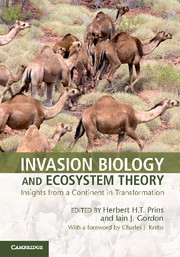Description
Invasion Biology and Ecological Theory
Insights from a Continent in Transformation
Coordinators: Prins Herbert H. T., Gordon Iain J.
A critical appraisal of ecosystem theory using case studies of plant and animal invasions in Australasia.
Language: English
Subject for Invasion Biology and Ecological Theory:
Publication date: 01-2014
540 p. · 18x25.3 cm · Hardback
540 p. · 18x25.3 cm · Hardback
Description
/li>Contents
/li>Biography
/li>
Many conservationists argue that invasive species form one of the most important threats to ecosystems the world over, often spreading quickly through their new environments and jeopardising the conservation of native species. As such, it is important that reliable predictions can be made regarding the effects of new species on particular habitats. This book provides a critical appraisal of ecosystem theory using case studies of biological invasions in Australasia. Each chapter is built around a set of eleven central hypotheses from community ecology, which were mainly developed in North American or European contexts. The authors examine the hypotheses in the light of evidence from their particular species, testing their power in explaining the success or failure of invasion and accepting or rejecting each hypothesis as appropriate. The conclusions have far-reaching consequences for the utility of community ecology, suggesting a rejection of its predictive powers and a positive reappraisal of natural history.
List of contributors; Foreword Charles J. Krebs; 1. Testing hypotheses about biological invasions and Charles Darwin's two-creators rumination Herbert H. T. Prins and Iain J. Gordon; Part I. Ancient Invaders: 2. Australia's Acacia: unrecognized convergent evolution Joseph T. Miller and Martin Burd; 3. The mixed success of Mimosoideae clades invading into Australia Kyle W. Tomlinson; 4. Perspectives from parrots on biological invasions Leo Joseph; 5. Invasion ecology of honeyeaters Janette A. Norman and Leslie Christidis; 6. The invasion of terrestrial fauna into marine habitat: birds in mangroves David Luther; 7. Biological invasions of Sirenia in relation to ecosystem theory Hans H. de Iongh and Daryl P. Domning; 8. Flying-foxes and drifting continents David A. Westcott and Adam McKeown; 9. Invasion ecology of Australasian marsupials Christopher R. Dickman; 10. Murine rodents - late but highly successful invaders Ken Aplin and Fred Ford; 11. Drift of a continent - broken connections Carol Ann Stannard; 12. The development of a climate - an arid continent with wet fringes Sandra McLaren, Malcolm W. Wallace, Stephen J. Gallagher, Barbara E. Wagstaff and Anne-Marie P. Tosolini; Part II. Modern Invaders: 13. Invasion of woody shrubs and trees Kris French, Ben Gooden and Tanya Mason; 14. Modern tree colonisers from Australia into the rest of the world Trevor H. Booth; 15. Failed introductions - finches from outside Australia Jan Komdeur and Martijn Hammers; 16. The skylark Judit K. Szabo; 17. Why Northern Hemisphere waders did not colonise the south Ken Kraaijeveld; 18. Weak migratory interchange by birds between Australia and Asia David Roshier and Leo Joseph; 19. Introducing a new top predator, the dingo Christopher N. Johnson and Mike Letnic; 20. The European rabbit - Australia's worst mammalian invader Steven R. McLeod and Glen Saunders; 21. The rise and fall of the Asian water buffalo in the monsoonal tropics of Northern Australia Patricia A. Werner; 22. A critique of community ecology and a salute to natural history Herbert H. T. Prins and Iain J. Gordon; Index.
Herbert H. T. Prins is Professor of Resource Ecology at Wageningen University. He was twice visiting professor with CSIRO and a Foundation Fellow of the Royal Melbourne Institute of Technology. He has conducted extensive fieldwork in environments ranging from savannas and rainforests, to mountains and the high arctic.
Iain J. Gordon is Chief Executive and Director of the James Hutton Institute. He has an international reputation for scientific leadership and research excellence in interdisciplinary approaches to understanding socio-ecological system dynamics. He worked for CSIRO for seven years, managing major research portfolios on land management to protect the Great Barrier Reef and conserving Australia's biodiversity.
Iain J. Gordon is Chief Executive and Director of the James Hutton Institute. He has an international reputation for scientific leadership and research excellence in interdisciplinary approaches to understanding socio-ecological system dynamics. He worked for CSIRO for seven years, managing major research portfolios on land management to protect the Great Barrier Reef and conserving Australia's biodiversity.
© 2024 LAVOISIER S.A.S.




